Couriers aside, road cycling has never really been cool. For too long it’s conjured up images of Dads in unreasonably snug lycra or commuters overloaded with testosterone and neon accessories (though never ‘good’ neon, obviously). For whatever reason road cycling has never embedded itself in our collective conscious the way Choppers, BMXs and, to a certain extent mountain bikes, have. But all of this could be about to change thanks to the popularity of fixed gear cycling in forward-thinking cities such as New York, San Francisco and London.
More commonly called ‘fixies’ these bikes strip riding down to its essence. There are no brakes on the handlebars and there is only one gear. The chain connects directly to the rear cog which in turn is bolted directly onto the back hub. Whenever the bike is in motion the pedals are turning, so coasting is not an option. Braking is by pure muscle power – reverse the pedals to slow down.
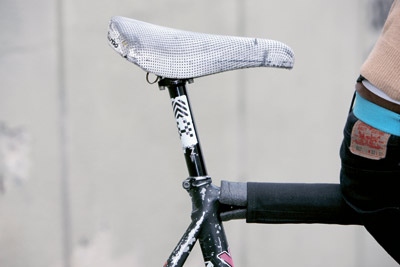
It’s an acquired taste and even the basics take a while to master. But just as skateboarding derives a certain purity by being just rider, board and city, so fixed gears too are simply rider, bike and city, and as you are always pedalling you are always in contact with the road. If you’re living in a concrete jungle, riding a fixie is probably the closest you will get to feeling flowing motion, the effortless symbiosis of human and machine.
If the fixed gear scene was created simply by removing brakes and derailleurs – the device which makes multiple gears a reality – then it began with the invention of bikes themselves. Over a century ago, when racing bikes in velodromes took off, fixed gears were favoured for their speed, agility and lack of weight. Having anything attached to the handlebars, such as brakes, could also prove lethal in a crash so bikes were kept as simple as possible.
It was urban cycle couriers who took the fixie onto the streets and created the subculture, which, as with skateboarding and surfing before it, is currently proving so attractive and now attracting interest from the mainstream. Where cycle commuters deck themselves out in day-glo and waterproofs, couriers, with their fashion and ‘opt-out of rat-race’ attitude have long been regarded as the cool cats of the mean city streets. Gap and Nike are a no-no, the brands to wear are SWRVE, Rapha and Harlot.

In San Francisco the mystery of the messenger clique was cemented with the production of MASH: SF an impossibly cool film by Mike Martin and skate director Gabe Morford which focussed on the skill and grace of urban riders. One of the things which comes across in the film is the strength and identity of the fixed gear community. Fixed gear and messenger forums carry lively debates and promises of pints as well as safety campaigns and plans for events. Last year’s World Cycle Messenger Championships took place in Dublin, every year Rollapaluza – a festival of roller-racing and associated cultural shenanigans – hits London town and alley-cat racing (think the racing scene in Grease but on bikes in the city to get the vibe) is rapidly increasing in popularity.
And just as BMXers use the city’s landscape as a playground, so fixed gear riders, when they’ve finished seamlessly cruising through traffic, are gathering to practise their skills with a series of tricks. Track stands – balancing on the pedals, doughnuts – cycling backwards in circles and 180 degree skids may sound like child’s play but they are tough to learn and show a certain amount of commitment to and knowledge of the bike.
Trixie Chix is a London-based collective of around 20 girls who meet once a week to do just that. Despite being only five months old, the Trixie Chix are already making a name for themselves. Roxy Erickson, 29, who is the brains behind the formation of the group said: “We have a team going to the upcoming roller-race and we are so new that about half of us race in the alley-cats in London. We are pretty active and we get involved.”
“When I first started riding there were only about three other girls in the whole of London who rode fixed and they were all messengers so there wasn’t much community feel for me. Trixie Chix is very laid back. We go for rides or practise tricks, play bike polo and sometimes we don’t even leave the pub.”
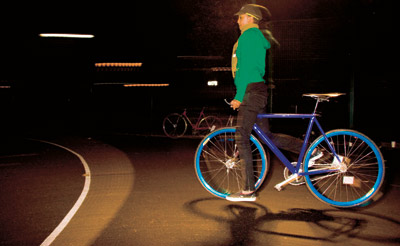
So why the recent appeal, especially to girls? “There’s something about the fundamental ethic of the fixed gear bike,” muses Debbie Burton whose website minx-girl.com specialises in urban messenger-style cycling clothes. “It has a purpose. It’s really easy to maintain so you don’t have to worry about riding around with loads of tools. But it’s not just about riding bikes, it’s a culture thing and a lifestyle because riding fixed is hard – you’ve got to love it.”
Plus there’s a growing amount of people wanting to channel that cycle courier chic, “I have always thought cycle messengers are so cool, their fashion, layers, skinny trousers, caps, looks good off and on the bike. If you’re a messenger it says something about you – you’re independent, not a follower,” she says. Certainly there seems to be an unspoken bond between riders. Eschewing brakes and gears marks you out as something of a purist, a response to the suspension forks, disc brakes and multiple cogs of mountain bikes which have been the bike of choice for many years.
But is there a possibility that the scene is too hip for its own good? If you bought a fixed gear bike new (warning: this is frowned upon – bikes should be built up and customised to be truly cool) the starting price is around £400 and custom builds can go way past the £1,000 mark.
“Demand has gone up about 1500 per cent,” jokes Patrick Trainor at Evans Cycles. “We now sell 15 different bikes from 10 different manufacturers and it’s become a much bigger part of what we sell as a company.” In other words, Tom, Dick and Sally want a piece of the hipster action, as was the case with skateboarding, snowboarding and just about every other burgeoning sub-culture, and such try-hard involvement can threaten the essence of the scene.
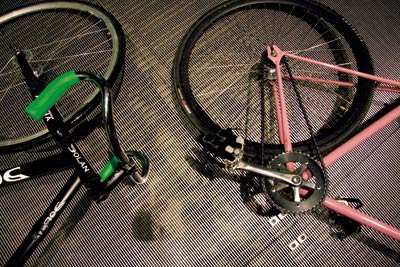
“I became addicted to my fixie before there ever was a hipster scene,” says Roxy. “I welcome that but this ‘tres chic’ attitude has almost created two different scenes now. Fixed gears are great because they are easy to maintain and in London you don’t need a geared bike. Simple as that. Using a fixed in San Francisco with all those hills seems ridiculous to me.” The blogger NYC Bike Snob is comically scathing about the inappropriateness of riding fixed gear bikes in urban areas, and he especially enjoys slating Bianchi Pista riders.
The ever-increasing mainstream appeal of fixies also throws up some interesting safety issues. Without the necessary skill, riding without brakes could be lethal. A court case in Portland, Oregon in 2006 highlighted the backlash when messenger Ayla Holland was fined for allegedly not having a brake on her bike. And writing on the Treehugger website Lloyd Alter caused a stir by saying that although we needed more people on bikes for a greener world “surely don’t we also need safer bikes with brakes?”
Debbie Burton says, “You have to really be into bikes to understand the grace of riding fixed and yes beginners on fixies on the road can be annoying. But if what it takes to get people riding bikes is that they are into it because they are having a fashion moment, then that’s not necessarily a bad thing.”
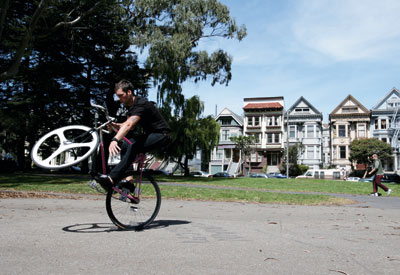 Where to get me a fixed gear bike…
Where to get me a fixed gear bike…
Fixed gear bikes are, at the moment, very much a London thing so if you want an off-the-peg model check out the Charge Plug chargebikes.com or the Bianchi Pista evanscycles.com and of the course the ubiquitous Condor condorcycles.com. While the Specialised Langster is ever-popular it is not really a purist’s machine. Most bikes come with a flip-flop hub – one side is fixed, the other a singlespeed which means you still only have one gear but you can coast – a good way of breaking yourself in gently.
For a more original build head to Brick Lane Bikes who specialise solely in fixed gears. Their prices start at £400 but include more quirky details like wide, colourful rims and bull horn bars. We also love lock-7.com and velorution.biz who both stock stylish and unusual bikes including fixed gear bikes.
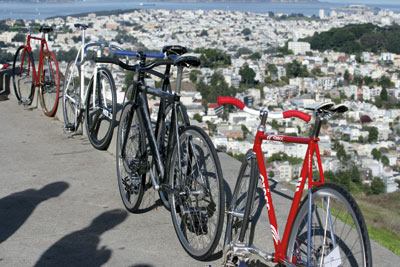
The web also has some good deals. fixedgearlondon.com will build you up a bike if you get in touch and the prices vary depending on what you have.
If you don’t feel up to building your own bike from scratch then try converting one. You will need horizontal dropouts – the bit on the rear forks which connect the axle to the frame – then the rest is pretty simple. Remove the un-needed sprockets and components, select the front chain ring for an agreeable ratio, switch the back sprocket from a coast-able freewheel into a track sprocket, re-space the rear axle so the chain is aligned, check the rear wheel is centred and put on a new chain. The best website for step-by-step instructions is sheldonbrown.com
Watch the Mash San Francisco trailer here!
